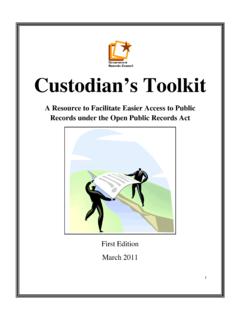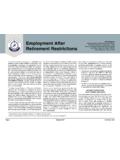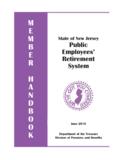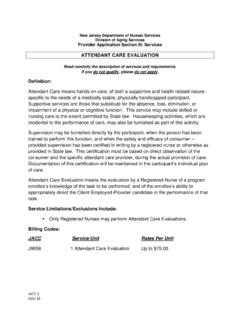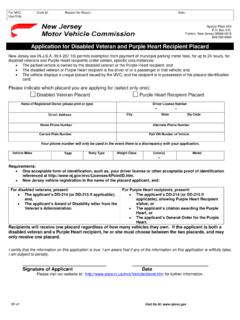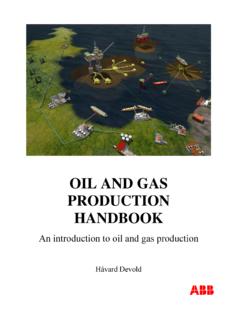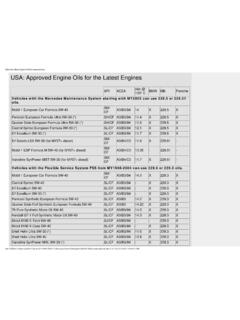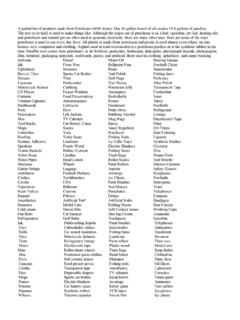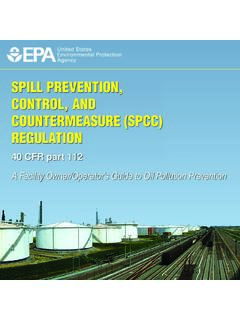Transcription of Guidance For The Use Of The Synthetic Precipitation ...
1 Guidance DOCUMENT DEVELOPMENT OF SITE-SPECIFIC IMPACT TO GROUND WATER SOIL REMEDIATION STANDARDS USING THE Synthetic Precipitation leaching PROCEDURE Version - November 2013 New Jersey Department of Environmental Protection Trenton, New Jersey Table of Contents I. Introduction 1 II. Instructions for Soil Sampling and Conducting the SPLP Test 2 A. Sampling, Extraction and Analysis Semivolatile Organic Chemicals and Inorganics 2 B. Sampling, Extraction and Analysis Volatile Organic Chemicals 3 III. Determination of the Leachate Criterion 5 A. Selecting a Default Leachate Criterion 5 B. Developing a Site-Specific Leachate Criterion 6 IV. Results Processing and Reporting 7 A. Calculation of Field Leachate Concentrations 7 B. Using Field Leachate Concentrations to Determine a Site-Specific Impact to Ground Water Soil Remediation Standard 9 Option 1.
2 Determination of a Site-Specific Soil Remediation Standard from Field Leachate Concentrations Arranged in Tabular Format 9 Option 2. Determination of a Site-Specific Soil Remediation Standard using a Site-Specific Kd Value 11 Option 3. Determination of a Site-Specific Soil Remediation Standard using SPLP Results and Linear Regression Analysis 12 C. Submission Requirements 13 V. Other Considerations 14 APPENDIX A Background Information on the Synthetic Precipitation leaching Procedure 17 APPENDIX B Default Leachate Criteria for Class II Ground Water ( g/L) 19 APPENDIX C Calculation of Leachate Concentrations under Field Conditions Using the Results of the Synthetic Precipitation leaching Procedure 23 References 29 1 I. Introduction The Synthetic Precipitation leaching Procedure (SPLP) is a United States Environmental Protection Agency (USEPA) SW-846 test method that can be used with soil samples from a contaminated site to estimate the site-specific adsorption-desorption potential of a contaminant that may impact ground water.
3 The SW-846 methods are available online ( ). The SPLP test is listed as SW-846 Method 1312, and details on conducting the SPLP test may be found at the following link: The procedure consists of a batch equilibrium experiment in which contaminant is partitioned between soil solids and an extracting solution, using a 20:1 ratio of solution to solid. The resulting solution is known as the leachate. Method 1312 directs the user to compare contaminant concentrations in the SPLP leachate to appropriate criteria to determine whether the contaminated soil represents an unacceptable leaching threat. For determination of New Jersey Impact to Ground Water Soil Remediation Standards (IGWSRS), the results from this test are first used to estimate the leachate concentration of a contaminant in soil solution under natural conditions in the field.
4 Then, the estimated field leachate concentration is compared to an appropriate leachate criterion (LC), to determine whether the contaminated soil represents a potential threat to ground water quality. If the estimated field leachate concentration exceeds the leachate criterion, the NJDEP has developed procedures to determine a site-specific impact to ground water soil remediation standard using results from the SPLP test. The SPLP procedure may often be the method of choice for determining cleanup standards for inorganic and low mobility organic compounds (see Appendix A). Low mobility organic compounds may be conveniently defined as those with Koc values greater than 20,000 L/kg (Roy and Griffin, 1985), and these values may be looked up in the chemical properties table in the Inhalation Soil Standards Basis and Background Document, or at the following link: Volatile organic contaminants may also be tested using the SPLP procedure.
5 Soil samples collected for SPLP extraction must be collected using an Encore sampler (or equivalent) as discussed below. Volatile contaminants are defined as those with Henry s law constants greater than 10-5 atm m-3 mol-1 and vapor pressures greater than 1 mm Hg at 25 C (NJDEP 2013). These are identified in Appendix B. Included in the necessary calculations for processing the results of the SPLP test is the determination of a site-specific soil-water partition coefficient (Kd). This parameter is used to estimate field leachate concentrations of the contaminant and to calculate site-specific remediation standards from SPLP test results. Details on these procedures are discussed in Section IV below. The Kd parameter may also be used in other options, such as in the SESOIL model, to develop site-specific impact to ground water soil remediation standards.
6 2 The SPLP option may be used at any time during the remediation process, provided that sufficient site data and information are available on which to base a standard. The Department has provided a spreadsheet that will enable the person conducting the remediation to quickly and easily generate soil remediation standards that will be protective of ground water for any given site: The spreadsheet carries out all the necessary calculations using the SPLP test results and calculates the site-specific remediation standard. The Department strongly recommends that the person conducting the remediation use this spreadsheet and include printouts of the spreadsheet in the appropriate submitted report. Methanol or any other preservation cannot be used with any soil samples collected for SPLP extraction because it affects contaminant desorption.
7 Prior to implementing this procedure, the user should review the additional considerations discussed in Section V of this document. Additional background information regarding this test method is provided in Appendix A of this Guidance . In 2012, the Department established a Committee to review and update the Guidance for the Synthetic Precipitation leaching Procedure for developing site-specific impact to groundwater soil remediation standards. The Committee included Stakeholders and NJDEP staff. This Guidance represents the work of the Committee and it supersedes any previous Department Guidance issued on this topic. The following people were on the Committee that prepared this document: Dr. Swati Toppin, Chair NJDEP George Blyskun NJDEP Ann Charles NJDEP Dr. Barry Frasco NJDEP MaryAnne Kuserk NJDEP Dr.
8 Paul Sanders NJDEP Matthew Turner NJDEP Michael Gonshor Roux Associates, Inc. Stephen Posten AMEC Environment and Infrastructure II. Instructions for Soil Sampling and Conducting the SPLP Test A. Sampling, Extraction and Analysis Semivolatile Organic Chemicals and Inorganics Ensure that a sufficient volume of soil is collected so that the SPLP test (100g soil required), total contaminant analysis (5 or 25g of soil required) and soil moisture tests can be conducted. Leachate concentrations and total contaminant concentrations are interrelated and the correlation 3 of these data can be used when developing site-specific remediation standards. Before the samples are split for SPLP and total contaminant analysis, the samples must be thoroughly mixed to yield uniform contaminant concentrations. 1.
9 Collect a minimum of three soil samples for each area of concern. (One exception to this requirement is when small fuel oil or diesel cases are being investigated see the Extractable Petroleum Hydrocarbon Guidance ): The number of samples collected shall be determined by the size of the area initially being investigated pursuant to soil remediation standards Guidance . The samples should include the highest suspected concentrations of the contaminants on site. Samples that represent a range of contaminant concentrations will be useful in conducting the procedures described below if some or all of the SPLP results exhibit unacceptable leachate concentrations. The samples should be representative of the variation in soil conditions over the area of concern, including variation with soil depth. Additional information regarding required field sampling techniques may be found in the NJDEP Field Sampling procedures Manual: After thoroughly mixing, split each sample and analyze as described below.
10 2. One sub-sample must be analyzed for total contaminant concentrations using appropriate methods as discussed in appropriate NJDEP rules and Guidance . 3. One sub-sample must be applied to the SPLP procedure described in USEPA SW-846, Analytical Method 1312. 4. One sub-sample must be used for soil moisture determination, to enable soil analytical results to be reported on a dry weight basis. 5. Measure the pH of the leachate sample at the conclusion of the SPLP extraction procedure. 6. Analyze the leachate for the contaminants of concern using appropriate methods as discussed in appropriate NJDEP rules and Guidance . B. Sampling, Extraction and Analysis Volatile Organic Chemicals When assessing soil contaminated with volatile organic chemicals, significant loss of these contaminants may occur during sample collection, preparation and analysis.
